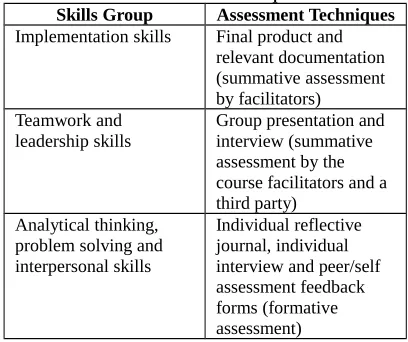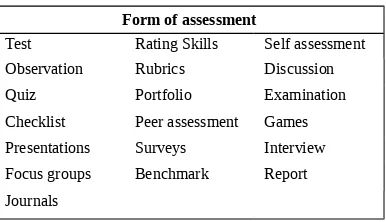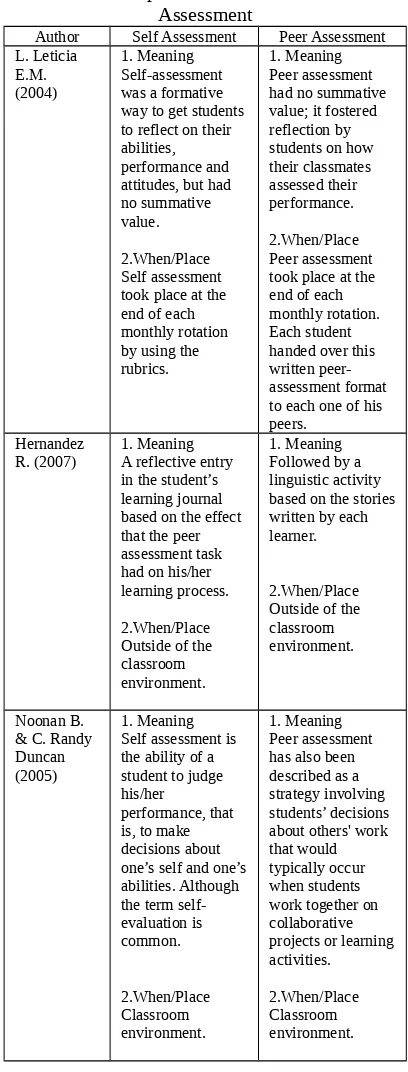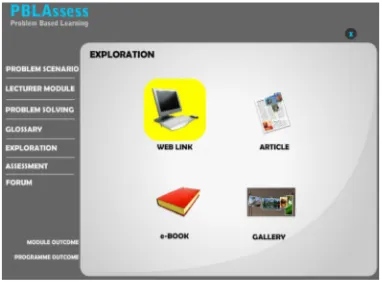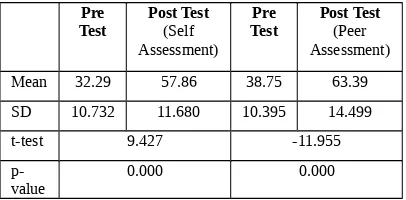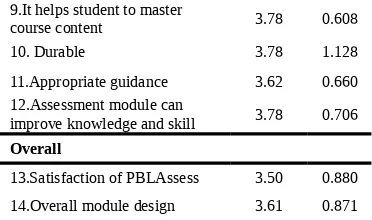Implementing PBL in Human Computer Interaction Class
Che Ku Nuraini Che Ku Mohd Department of Interactive Media Faculty of Information and Communication
Technology
Universiti Teknikal Malaysia Melaka Hang Tuah Jaya, 76100 Durian Tunggal,
Melaka, Malaysia. cknuraini@gmail.com
Faaizah Shahbodin2, Norasiken Bakar3, Kalthom Husain4, Hazmilah Hasan5 Department of Interactive Media
Faculty of Information and Communication Technology Universiti Teknikal Malaysia Melaka
Hang Tuah Jaya, 76100 Durian Tunggal, Melaka, Malaysia.
faaizah@utem.edu.my2,
norasiken@utem.edu.my3,
kalthom@utem.edu.my4,
hazmilah@utem.edu.my5
Abstract: Problem Based Learning (PBL) is increasingly used in many disciplines. PBL can be defined as a pedagogical strategy for posing significant, contextualized, real world situations, providing resources, guidance, instruction to learners as they develop content knowledge and problem solving skills. The purpose of this research is to evaluate effectiveness of students’ performances between self and peer assessment based on student’s preferences. The course entitled Human Computer Interaction (HCI) which constitutes a compulsory subject for students in the undergraduate Bachelor in Computer Science degree programmes. Three phases involved in this research methodology. Phase one is Analysis which includes literature survey and collection of preliminary analysis data. Second phase is Designing and Development which adopt ADDIE model as a basis for multimedia development. The last phase is Testing and Evaluation. There are three research instruments gathered to evaluate the project which are questionnaire, interview and prototype development. The prototype called PBLAssess is developed to support the effectiveness of teaching and learning. Findings of this study revealed that students prefer peer assessment than self assessment. The use of PBLAssess can increase student’s understanding towards the topic that has been taught. Results showed that assessment in PBL is significantly related to student’s performances and preferences.
Keywords: Problem Based Learning, Multimedia, Human Computer Interaction, Self Assessment, Peer Assessment
I. INTRODUCTION
Learning begins with a problem. Problem Based Learning (PBL) is in action worldwide at virtually every level of education or training imaginable. Looking beyond traditional content objectives, PBL and information technology together provide exciting new
contexts for achieving active learning and technology objectives associated with higher education. Integrating technology and PBL are winning strategies and well worth of investment of faculty time and energy to benefit student’s learning in our classrooms and courses. PBL is the most significant innovation in educational area in the recent years. It is increasingly to be used in diverse ways across different subjects and disciplines in some universities. Even since Information Communication & Technology (ICT) becomes popularly used in teaching and learning, there is enormous to integrate PBL within online environment (Watson G., 2002; Savin-Baden, 2007). PBL was officially adopted as a pedagogical approach in 1968 at McMaster University, a Canadian medical school. PBL has been widely used across a considerable range of subjects and professionals areas in higher education. Many have written about approaches to PBL, curriculum design, the role of the tutor and various other aspects but much less attention has been given to assessment in PBL. Many students find PBL motivations as they realize that is really about how they learn outside the classroom (MacDonald R., 2001). The result is that difficulties are emerging as many people retain the assessment methods they used in their traditional approaches resulting in a misalignment between their objectives, student learning outcomes, learning, teaching methods adopted and the assessment of student learning (Macdonald, R. & Savin-Baden, M., 2004).
the topics include Introduction of HCI, Cognitive Psychology, User Interface Design (UID), Interaction Design, Usability and Evaluation. Other topics such as User Centered Design, Task Analysis and User Support Design are also covered. Basically, the module designed for this course is used in teaching all second year Faculty of Information Communication & Technology (FICT) students. The objectives of this course are to expose students to understand the relationship between cognitive psychology and user interface design, differentiate between mental models, conceptual model and also design user interface for various computer applications such as web sites or products.
PBL is not a new approach which can be applied in this university but it can promote continuous active and self-directed learning among students compared to traditional learning. MacDonald and Isaac (2001) explained the characteristic that distinguishes PBL from other learning methods is the problem comes before the knowledge needed to solve or resolve it. One of the primary features of PBL is student-centered. “Student-centered” refers to learning opportunities that are relevant to the students, the goals of which are at least partly determined by the students themselves. It is hoped that this study will be able to show how UID topic in HCI could contribute to the effective teaching and learning especially using PBL approach.
II. LITERATURE REVIEW
The use of PBL in computer based is different from traditional environment. It also can enhance learning experience especially in the assessment part. Assessment is a tool used to reflect the education outcomes. The results of assessment are used to judge and rate not only for the students, but also for the lectures, departments and institutions. For example, in UTeM the result gives the benefits to control learning outcomes in relation to the pre-established learning goals. They need assessment to set education standard, monitor the quality of education, monitor student’s learning process and academic promotion. Several assessments forms may be used to assess learners’ use of elaborated knowledge in solving problem. Since the primary goal of PBL is to instill an attitude and character that will enhance the students’ abilities to work in group, to solve new complex and ill-structured problem, critical thinking and self-directed
learning skill, then assessment in PBL must value these skills. Mitchell and Delaney (2004) identified four core issues that need to be addressed when assessing students in a group project setting, namely;
1. Assessment of the group performance.
2. Assessment of the individual contribution to the group.
3. Assessment of the project deliverables.
4. Assessment of the course success.
From those criteria, assessment of the group, the individual and the project deliverables in the small group PBL project course, were entered into three skills groups which were identified from the course objectives that have been implemented in their study. There are Implementation skills, Teamwork and leadership skills, and Analytical thinking, problem solving and interpersonal skills as tabulated in Table 1. The skill is adopted from Mitchell & Delaney (2004).
Table 1: Summary of skills groups and
assessment techniques
Skills Group Assessment Techniques
Implementation skills Final product and relevant documentation (summative assessment by facilitators)
Teamwork and leadership skills
Group presentation and interview (summative assessment by the course facilitators and a third party)
Analytical thinking, problem solving and interpersonal skills
Individual reflective journal, individual interview and peer/self assessment feedback forms (formative assessment)
A. Problem Based Learning (PBL)
bases and skills by placing students in the active role of problem solvers confronted with an ill-structured situation that simulates the kind of problems they are likely to face as future managers in complex organizations. There are many different ways of implementing PBL but underlying philosophies associated with it as an approach are broadly more student-centered than those underpinning traditional PBL (MacDonald, R. & Savin-Baden, M., 2004). Relative to conventional lecture based methods in which information is transferred from teacher to student, the research literature suggests that based upon the literature reviews noted below:
PBL promotes more versatile studying methods and PBL students are more likely to use the library resources to study.
PBL develops greater knowledge retention and recall skills.
PBL is an instructional methodology solution to enhance learning by requiring learners to solve problems. It is a methodology with the following characteristics (Hung, W., Jonassen, D. H., Liu R., 2006). PBL is problem focused where learners begin learning by addressing simulations of an authentic, ill-structured problem. The content and skills to be learned are organized around problems, rather than as a hierarchical list of topics. Knowledge building is stimulated by the problem and applied back to the problem. It is student centered because faculty cannot dictate learning. It is self-directed where students individually and collaboratively assume responsibility for generating learning issues. The processes through self assessment and peer assessment in PBL can assess their own learning materials. It is self reflective where learners monitor their understanding and learn to adjust strategies for learning. In PBL, tutors are facilitators who support and model reasoning processes. They also facilitate group processes, interpersonal dynamics, probe students’ knowledge deeply, and never interject content or provide direct answers to questions. One of the strengths of PBL is that students are placed in the position of finding out appropriate information for themselves (MacAdrew et al., 2008).
PBL follows a simple cycle. The facilitator role of the tutor varies with each stage of cycle. The teacher must ensure that all group members know the stages of the PBL. Although the steps are listed in a straight forward fashion, there is often some overlap,
rethinking as the group proceeds. The steps are proposed by Hafiza A. (2010) stated as below:
i. Identify the problem
ii. Explore the pre-existing knowledge
iii. Generate hypothesis and possible mechanisms
iv. Identify learning issues v. Self study
vi. Re-evaluation and application of new knowledge to the problem vii. Assessment and reflection of
learning (Walsh A., 2005)
B. Assessment in PBL
Traditionally, assessment has been about finding out how much students know usually in terms of knowledge or content. However, in PBL what we are really interested in is the students’ ability to perform in a professional context, to recognize their need to acquire new knowledge, skills and to view learning holistically rather than atomistically (MacDonald, R. & Savin-Baden, M., 2004). Assessment is the process of gathering and discussing information from multiple diverse sources in order to develop a deep understanding of what students know, understand, can do with their knowledge as a result of their educational experiences and the process culminates when assessment results are used to improve subsequent learning (Huba & Freed, 2000). Definition from the Assessment Reform group (2002), “Assessment for learning is the process of seeking and interpreting evidence for use by learners and their teachers to decide where the learners are in their learning, where they need to go and how best to get there”. Assessment is compatible with PBL and the specific discipline or profession (Savin- Baden, 2004; Raine & Symons, 2005). There are many forms of assessment in PBL. Some of the assessments have been used successfully in PBL and which also move away from the need to have outcome based examinations. Table 2 shows forms assessment in PBL:
Table 2: Forms assessment in PBL
Form of assessmentTest Rating Skills Self assessment
Observation Rubrics Discussion
Quiz Portfolio Examination
Checklist Peer assessment Games
Presentations Surveys Interview
Focus groups Benchmark Report
C. Self Assessment
Self assessment is judging the quality of ones own work (O’Grady G., 2004). It is a process where students are involved in and responsible for assessing their own piece of work. It encourages students to become independent learners so they can increase their motivation. The self assessment allows the learners to compare the standards achieved by the other learners against their own work (Race P. et al., 2005). It usually allows them to assess aspects of their work such as the range of vocabulary, originality and structure. For the self assessment, the feedback is immediate in the sense that the students mark their performance using the detailed rubric, and based on this determine the actions they need to take to develop required knowledge and skills. It gives people the choice to access their own needs or carry out an assessment on behalf of someone else. Self assessment can take many forms
-Self-assessment checklists and inventories
-Teacher-student interview
D. Peer Assessment
Peer assessment is the act of students assessing one another (Boud, D., et al., 2001). Peer assessment is defined as students grading the work or performance of their peers using relevant criteria (Falchikov, N., 2001).Students must have a clear understanding of what they are to look for in their peers' work. Peer assessment is quite different from self-assessment. There is evidence that peer feedback enhances student learning (Falchikov, N., 2001) as students are actively engaged in articulating evolving understandings of subject matter. However, in peer assessment students are making assessment decisions on other students’ work. The students can comment and judge their colleagues work. It also encourages student’s thinking skills. Bostock (2000) points out that peer assessment encourages the students to be independent and develops skills in high cognitive areas. Peer assessment can help self assessment. Peer assessment will help students become more autonomous, responsible and involved, encourages students to critically analyze work done by others, rather than simply seeing a mark. The real
purpose is to allow students to gain feedback from each other. According to the previous researchers, self and peer assessment can be explained in Table 3.
Table 3: Explanation of Self and Peer Assessment
Author Self Assessment Peer Assessment
tend to rate others higher than their own evaluation suggesting students were not simply rating on the basis of self interest. It is important to help students in developing judgement about their own and other’s performance by taking peer and self assessment when assessing students.
III. METHODOLOGY
A. Participants
The purpose of this research is to evaluate the effectiveness of assessment in PBL between self and peer assessment. Several assessment forms may be used to assess learner’s use of elaborated knowledge in solving problem. Therefore PBL is an educational approach in which students and tutors need to know what is going on during the learning process itself. Thus, in the present study would focus on assessment of learning process and the quality of students’ improvement. To elevate this idea, an appropriate form of assessment namely self and peer assessment is proposed.
Table 4 shows the analysis result for Human Computer Interaction (HCI) subject. Analysis of the result has been done based on performance report for HCI subject on semester 1 2009/2010 session.
Table 4: Analysis of HCI result for Semester 1 2009/2010
Topic N Mean DeviationStd.
Cognitive
Psychology 56 6.18 2.327
User Interface
Design 56 3.66 2.273
Usability & Usability Engineering
56 5.16 3.106
User Centered
Design 56 5.94 2.622
Prototyping 56 3.40 3.110
Design
User Support 56 19.22 4.404
There are 56 students taking Human Computer Interaction (HCI) subject for Semester 1 2009/2010. HCI subject consists of 12 chapters namely Introduction, Cognitive Psychology, User Interface Design, Interaction Design, Usability and Usability Engineering,
Evaluation, User Centered Design, Task Analysis, Prototyping, Design User Support, Accessibility Issues and Design Issues. It focuses on Chapter 3 which is User Interface Design (UID). The topics include Cognition, Mental model vs. Conceptual model, User Interface Components and 3D interfaces. Analysis shows that UID topic has the lowest standard deviation= 2.273 and mean=3.66. Based on the result, the highest mark gathered by the students for UID topic is only 9 out of 20 compared to other topics in HCI subject. Majority of students scored higher mark for Design User Support topic. It shows that this topic is easier than other topics which carry the highest mark, 27.
B. ADDIE Model
Figure 1: ADDIE Model
In the part of content, the prototype PBLAssess is developed based on ADDIE model. Figure 1 shows the flow of ADDIE model. The ADDIE Model is a term used to describe a systematic approach to instructional development. ADDIE model can be applied to any kind of learning solution. The five phases consist of Analysis, Design, Development, Implementation, and Evaluation. Each phase represents a series of tasks that help to ensure development efforts stay on track, on time and on target. Solution to the problem is analyzed thoroughly to ensure that the solution impacts performance in a positive way. The ADDIE model is used because basically generic, systematic, step-by-step framework used by instructional designers, developers and trainers to ensure course development and learning
does not occur in a hazardous or unstructured way.
Analysis
Design
Development
Implementation
C. Screen Design
The development process of PBLAssess includes the creation of the instructional materials. The instructional materials contain the information that the student will use to achieve the objectives. The PBLAssess can be designed by selecting content, media and type of interactivity that best underpins these learning objectives. PBLAssess is consisting five modules: 1) Problem Scenario, 2) Lecturer Module, 3) Problem Solving, 4) Exploration and 5) Assessment. The PBLAssess environment, scenario and example of module are shown as figure 2, 3, 4,5,6 and 7.
Figure 2: Problem scenario presented as a trigger for discussions of the problem
Figure 3: Lecturer module
The icon of subtopic topic in User Interface Design.
Figure 4: Exploration module
The extended resources provided in this module will help student in understanding the problem.
Figure 5: Problem solving
Students can solve their problem solving skills using as FILA table
Figure 6: FILA table form
Students can solve their problem solving skills using as FILA table
Figure 7: Assessment module There are two form of assessment in PBLAsssess which is self and peer assessment.
D. Research Design and Questionnaire
variables. Requirements are things the project must deliver. The requirement is important in order to develop final result and delivers the output expectation. The instruments used to collect data are questionnaire, interview and development of prototype. Below are the explanations of the requirement:
1. Questionnaire -A set of checklist questions are prepared based on based on three factors which are course content, learning materials and assessment and evaluation.
2. Interviews -A set of interview questions has been constructed for the interviews. Two lecturers teaching HCI course are involved in the interview. Interview is chosen for data collection because it can provide some of the valuable information, particularly on topics related to the respondent’s feelings and belief. 3. Prototype - Prototype development is
the creation of the first working model of a new product or invention. The prototype called PBLAssess is the next step in the sequence.
IV. RESULT AND DISCUSSION
Table 9 shows the result of t-test and p-value for self and peer assessment using PBLAssess. The test employs paired sample t-test. Based on the performance of the students in t-test using self assessment (pre) and self assessment (post) assessment preferences in PBLAssess, the t-value is 9.427 and the significance of two tailed value, p is 0.000. In the next series, of peer assessment (pre) and peer assessment (post) assessment preferences in PBLAssess, the t-value is -11.955 and the significance of two tailed values, p is 0.000. The result shows, p< 0.05, thus there is a significant difference between using of self assessment and peer assessment in PBL. Hence, the null hypothesis H01 is rejected.
Table 9: Pre and Post Test Result
Testing
Mean 32.29 57.86 38.75 63.39
SD 10.732 11.680 10.395 14.499
t-test 9.427 -11.955
p-value
0.000 0.000
Based on the result, peer assessment performs highest mean compare to self assessment in PBL. Hence, the result indicates that peer assessment perform better that self assessment among students at UTeM. The Human Computer Interaction (HCI) subject focuses on the User Interface Design topic as a case study in this research. Peer assessment also can be used to enhance the quality of students’ personal improvement and their contribution on group work (Roberts T.S., 2006).
A. Student Performances and Preferences
Table 10: Mean, SD and t-value
Student’s peer assessment in PBLAssess is 67.14 (SD = 15.538) which is higher than the average of using self assessment in PBLAssess, 59.09 (SD = 14.110). The t-value for group that prefers peer assessment is 2.580 and p-value is 0.023. Since the p-value is smaller than 0.05 (p<0.05), there is a significant difference between the result of using peer assessment and self assessment. Thus, there is a positive relationship between peer assessment student preferences and their performances.
finding is strongly supported by the statistical result which shows the highest average score of 57.50 as compared to group using self assessment with average score of 56.50. The t-value for the group that prefers self assessment is -0.632 and p-value is 0.000. The p-value is smaller than 0.05 (p>0.05), there is a significant difference between the result of using self and peer assessment. Thus, there is a negative relationship between linear student’s preferences and their performances.
B. Effectiveness of PBLAssess
The research aims to determine the effectiveness of using PBLAssess which has been developed using a PBL approach. The questionnaires were categorized under four construct which are the Course Content, Learning Sources, Assessment and Evaluation and Overall. The Cronbach’s alpha reliability coefficient was calculated for each of the constructs and the result is shown in Table 11. The questionnaire consist of 14 items and each item was accompanied by a 5-point Likert scale, with 1 denoting the most disagreeable and 5 denoting the most agreeable. The findings effectiveness of PBLAssess can be seen in Table 12.
Table 11: Construct of the questionnaires
Construct Cronbach AlphaValue
Course Content 0.813 Learning Sources 0.321 Assessment and
Evaluation 0.766
Overall 0.834
Table 12: The effectiveness of
PBLAssess
Item
n = 56 Mean SD
Course Content
1.Develop subject knowledge 3.91 0.641
2.Easy to understand 3.72 0.888
3.Easy used by novice user 3.75 0.842
4.Easy to learn 3.53 1.077
5.The consistency of content 3.81 0.780
Learning Sources
6.Provide extended learning
sources and example 3.94 0.669
7.Additional reading and
materials 3.50 0.950
Assessment and Evaluation
8.Criteria of assessment are
clear and approriate 3.59 0.875
9.It helps student to master
course content 3.78 0.608
10. Durable 3.78 1.128
11.Appropriate guidance 3.62 0.660
12.Assessment module can
improve knowledge and skill 3.78 0.706
Overall
13.Satisfaction of PBLAssess 3.50 0.880
14.Overall module design 3.61 0.871
SD=Standard Deviation
V. CONCLUSION
With the development of PBLAssess, it enhances learning especially assessment part because it gives new opportunities for sharing information, resources and expertise. At the end of the PBL session, it was observed that majority of students enjoy using the PBL approach in the course. It is important to build trust among students and between facilitators and the learners so they are able to create a relaxed atmosphere especially in PBL environment. The process of PBL lends itself well to the definition of learning as understanding because assessment is regarded as an integral element in the facilitation of learning (O’Grady G., 2004). There are also many areas in PBL and assessment that are still open issues. Other educators should also consider using PBL in the classes and the assessment techniques used can easily be applied to study its impact on enhancing student learning in their course.
The learning strategy used in a course must keep its coherence with the content area and with the evaluation system. Hence, PBL assessment should focus not only on the process itself, but also on the outcomes it should incorporate both, course objectives and those fostered by PBL (Montemayor, L.E., 2004). In general, students performed better in assessment on PBL course.
A. Contribution
learning regarding the development of life long skills, meta cognitive competencies or affective abilities (Topping, 2003).
The real problem scenario is presented using 2D animation. This is to attract student’s understanding regarding the problem presented. In PBLAssess, the extensive resources are provided in Exploration module. It consists of learning resources for students’ access which are Web Links, Article, e-Book, Gallery, Glossary and Forum.
PBLAssess also provides real time online collaborative learning which is accessible to the UTeM Official E-Learning portal or uLearn(http://ulearn.utem.edu.my/). The research also proposes the rubrics of scoring performance assessments which is modified from Alabama (2003) and Classic Exemplars Rubric (2006). Rubrics can be created in a variety of forms and levels of complexity. However, in this research the development of rubric focused on measuring a stated objective. Besides that, it also encourages active involvement on the assessment part among the students. The students are not under pressure to carry out the assessment in PBL because they actually learn more of the course content. It can help students perceive assessment tasks as integral to the subject. When students participate in the assessment, it can help them understand how assessment works. It will propose new assessment techniques to the faculty and the students.
In the testing that conducted among FTMK students, it proves that using peer assessment give the students the experience of having to clearly explain their thoughts and to refine those that were not clear to their fellow students. Self and peer assessment promote the values of the learning process. The self assessment allows the learners to compare the standards achieved by the other learners against their own work (Race P. et al., 2005). It usually allows them to assess aspects of their work such as the range of vocabulary, originality and structure. It is also recognized that peer assisted learning which can have a motivating effect on the teams and mentoring between teams should be encouraged and rewarded (Frank, M., & Barzilai, A., 2004). From the study, it hopes that assessment in PBL can be enhanced to the other technical subject at UTeM especially in ICT and Engineering field.
ACKNOWLEDGEMENT
This study was sponsored by university short grant, University Technical Malaysia Melaka (UTeM), project number: PJP/2009/FTMK (12)591.
REFERENCES
[1] Alabama Professional Development Modules (2003).Scoring Performances Assessment: Checklist, Rating Scales and Rubrics. Institute for Assessment and Evaluation. University of Tennessee
[2] Assessment Reform Group (2002). Assessment for learning. Learning and Skills Improvement Services (LSIS).
[3] Boud, D. Cohen, R. & Sampson, J. (2001). Peer learning and assessment In Peer Learning in Higher Education. London, Kogan Page. pp.67-81.
[4] Bostock, S. (2000). Student Peer Assessment, Learning Technology, retrieved July 28, 2010, from
http://www.keele.ac.uk/depts/aa/landt/lt/docs/b ostock_peer_assessment.htm.
[5] Classic Exemplars Rubric (2006).Standard based assessment. Vermont.
[6] Falchikov, N. (2001). Learning together: peer tutoring in higher education (London, Routledge Falmer).
[7] Frank, M., & Barzilai, A. (2004). Integrating alternative assessment in a project-based learning course for preservice science and technology teachers. Assessment & Evaluation in Higher Education, Vol. 29(1), pp.41-61.
[8] Gary, C. & Max, E. (2004). Introduction to the Special Issue: Problem Based Learning as Social Inquiry- PBL and Management Education, Journal of Management Education, vol 28, no.5, pp 523-535.
[9] Hung, W., Jonassen, D. H., Liu R., (2006). Problem-Based Learning. Paper presented at AERA Annual Meeting, April 8–12, San Francisco, CA.
[10] Levin, B. B. (Ed.) (2001). Energizing teacher education and professional development with problem based learning. Association for Supervision and Curriculum Development. [11] Hafiza A. (2010). Problem Based Learning
(PBL). Medical Education Department, School of Medical Sciences, Universiti Sains Malaysia. Published in Malaysia. ISBN: 978-967-5547-04-1.
[12] Hernandez R. (2007). Using Peer and Self Assessment Practices to Assess Written Tasks. Case Studies of Good Practices in Assessment of Student Learning in Higher Education.
[13] Huba, M. E. & Freed, J. (2000). Learner-centered assessment on college campuses: Shifting the focus from teaching to learning. Needham Heights, MA: Allyn & Bacon. [14] MacAndrew, S.B.G., et al. 2008. Problem
based learning in practice: listening to lecturers. An investigation of academics’ perceptions and practice concerning problem based learning. Higher Education Academy Scotland.
[15] Macdonald, R. (2001).Problem-based learning in higher education: untold stories. Studies in Higher Education, Vol. 26(3), pp. 385-386.
problem-based learning. Teaching Education. Vol.12, pp. 315-333.
[17] Macdonald, R. & Savin-Baden, M. (2004). A Briefing on Assessment in Problem Based Learning. LTSN Generic Centre
Learning and Teaching Support
Network. ISBN 1-904490-52-9.
[18] Marinick, M.H. (2001). Engaging Students in Problem-Based Learning mcli Forum: Spring 2001: Teaching and Learning (1). [19] Mitchell, G. G., Delaney J. D. (2004). An
Assessment Strategy to Determine Perceived Learning Outcomes on a Problem-based Learning Software Engineering Group Project Course, The International Journal of Engineering Education, 20(3):494-502.
[20] Montemayor L.E. (2004). Formative and Summative Assessment of the Problem Based Learning Tutorial Session Using a Criterion Referenced System. IAMSE 2004. Vol. 14(8).
[21] Neo. T. K. (2003). Using multimedia in a constructivist learning environment in the Malaysian classroom. Australian Journal of Educational Technology,Vol. 19(3), pp. 293-310.
[22] O’Grady G. (2004). Holistic Assessment and Problem Based Learning: PBL at the Republic Polytechnic 5th Asia-Pacific
Conference on PBL.
[23] Race, P., et al. (2005). 500 tips on assessment. London: Routledge Falmer, second edition.
[24] Raine, D & Symons, S. (2005).Experiences of PBL in Physics in UK Higher Education, in Poikela, E. and Poikela, S. (eds.), PBL in context: Bridging Work and Education. Tampere:Tampere University Press.
[25] Savin-Baden, M. (2007).A Practical Guide to Problem Based Learning Online, Routledge. [26] Topping, K. (2003) Self and peer assessment in
school and university: reliability, validity and utility. In M. Segers, F. Dochy, and E. Cascaller (Eds.), Optimising new modes of assessment: in search of qualities and standards, pp. 55–87. Dordrecht: Kluwer Academic Publishers.
[27] Uden, L. and C. Beaumont (2006), Technology and Problem Based Learning. Hershey, PA: Information Science Publishing.
[28] Walsh, A., ( 2005), The Tutor in Problem Based Learning: A novice’s guide, Mc Master university, Faculty of Health sciences.
[29] Watson, G. (2002).Using Technology to Promote Success in PBL Courses.
Available from :
